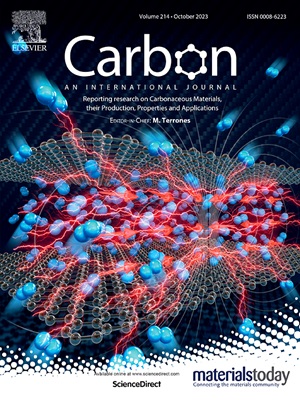从大蒜废物中提取的功能化纳米多孔生物碳,用于增强二氧化碳捕获和超级电容器性能
IF 10.5
2区 材料科学
Q1 CHEMISTRY, PHYSICAL
引用次数: 0
摘要
从生物质中提取的纳米多孔活性生物炭在各种应用中提供了传统碳材料的可持续替代品。尽管有多种方法可以用不同的生物质和活化剂制备这些碳材料,但仍然存在许多挑战,如优化孔隙结构,表面功能化控制和保持高导电性,这是实现高性能储能应用的关键。这些挑战可以通过选择具有不同化学结构和组成的适当生物质来克服。本研究以厨余大蒜为原料,以氢氧化钾(KOH)为活化剂,通过活化工艺合成纳米多孔生物碳。所得生物碳具有3449.2 m2 g−1的高比表面积和1.67 cm3 g−1的孔隙体积,并具有硫和氧官能团。通过热解对孔隙结构进行微调,实现微孔和介孔的平衡,有利于能源储存和碳捕获的应用。纳米结构材料在低压(1 bar时5.25 mmol/g)和高压(0°C和25°C 30 bar时30.6和24.9 mmol/g)下具有出色的CO2吸附能力,使其成为燃烧后和燃烧前CO2捕获的有前途的吸附剂。这些突破性的研究与动态吸附模型(如Yoon-Nelson和Thomas模型)相结合,证明了在实际应用中具有优越的CO2捕获和速率常数。此外,生物碳作为超级电容器电极表现出优异的电化学性能,在0.5 a g−1下的比电容为262 F/g,并且具有良好的保持和库仑效率,超过10,000次循环的稳定性。氧和硫官能团的存在增强了亲水性和润湿性,有助于优异的电化学性能。该研究强调了功能化纳米多孔生物碳的潜力,该纳米多孔生物碳具有可调的多孔结构,来源于废弃生物质,是一种可持续和高效的二氧化碳捕获和能源储存材料。本文章由计算机程序翻译,如有差异,请以英文原文为准。
Functionalized nanoporous biocarbon derived from garlic waste for enhanced CO2 capture and supercapacitor performance
Nanoporous activated biocarbons derived from biomass offer a sustainable alternative to traditional carbon materials in various applications. Even though multiple methods are available to prepare these carbon materials with different biomasses and activating agents, there are still many challenges such as optimizing pore structure, surface functionalization control, and maintaining high electrical conductivity which are critical to achieve high performance in energy storage applications. These challenges can be overcome by choosing the appropriate biomass with different chemical structure and composition. Herein, we use food waste garlic to synthesize nanoporous biocarbon through the activation process using potassium hydroxide (KOH) as an activating agent. The resulting biocarbon exhibited a high specific surface area of 3449.2 m2 g−1 and a pore volume of 1.67 cm3 g−1, together with sulfur and oxygen functionalities. Pyrolysis was employed to fine-tune the pore structure, achieving a balance of microporosity and mesoporosity, which are beneficial for energy storage and carbon capture applications. The nanostructured materials delivered exceptional CO2 adsorption capacity at low (5.25 mmol/g at 1 bar) and high pressure (30.6 and 24.9 mmol/g at 0 and 25 °C at 30 bar), making it a promising sorbent for both post-combustion and pre-combustion CO2 capture. The breakthrough studies combined with the dynamic adsorption models like the Yoon-Nelson and Thomas models demonstrated superior CO2 capture and rate constant for practical applications. Furthermore, the biocarbon revealed excellent electrochemical performance as a supercapacitor electrode with a specific capacitance of 262 F/g at 0.5 A g−1 and stability over 10,000 cycles with excellent retention and coulombic efficiency. The presence of oxygen and sulfur functionalities enhanced hydrophilicity and wettability, contributing to the superior electrochemical performance. The study highlights the potential of functionalized nanoporous biocarbon with a tunable porous structure derived from waste biomass as a sustainable and efficient material for CO2 capture and energy storage applications.
求助全文
通过发布文献求助,成功后即可免费获取论文全文。
去求助
来源期刊

Carbon
工程技术-材料科学:综合
CiteScore
20.80
自引率
7.30%
发文量
0
审稿时长
23 days
期刊介绍:
The journal Carbon is an international multidisciplinary forum for communicating scientific advances in the field of carbon materials. It reports new findings related to the formation, structure, properties, behaviors, and technological applications of carbons. Carbons are a broad class of ordered or disordered solid phases composed primarily of elemental carbon, including but not limited to carbon black, carbon fibers and filaments, carbon nanotubes, diamond and diamond-like carbon, fullerenes, glassy carbon, graphite, graphene, graphene-oxide, porous carbons, pyrolytic carbon, and other sp2 and non-sp2 hybridized carbon systems. Carbon is the companion title to the open access journal Carbon Trends. Relevant application areas for carbon materials include biology and medicine, catalysis, electronic, optoelectronic, spintronic, high-frequency, and photonic devices, energy storage and conversion systems, environmental applications and water treatment, smart materials and systems, and structural and thermal applications.
 求助内容:
求助内容: 应助结果提醒方式:
应助结果提醒方式:


